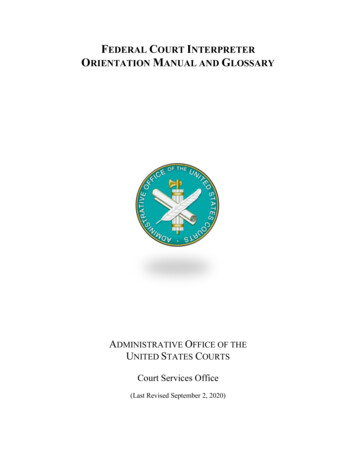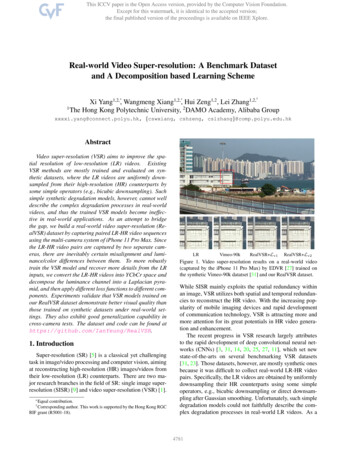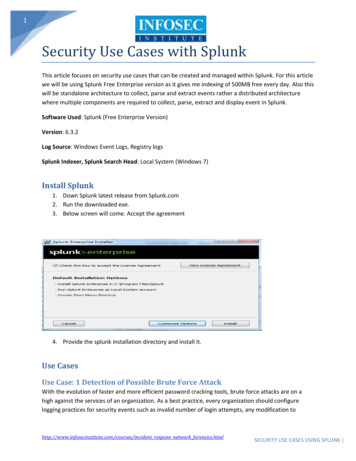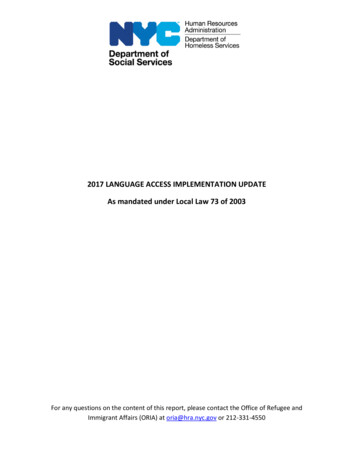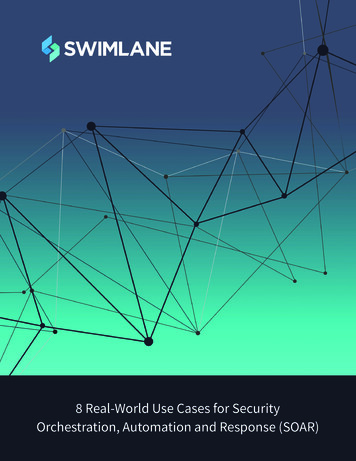
Transcription
8 Real-World Use Cases for SecurityOrchestration, Automation and Response (SOAR)
IntroductionSecurity operations present an escalating series of management challenges. As thefrequency and variety of attacks accelerate, even the best teams can get overwhelmed.Security orchestration, automation and response (SOAR) offers a solution. Eighty toninety percent of most security operations’ tasks can be automated to some extent, andthe data that disparate tools create can be distilled into a single pane of information.The resulting efficiency gains allow security teams to handle vastly more tasks whilesignificantly decreasing mean times to resolution (MTTR).Sounds good in theory, but how does security operations teams use SOAR in the realworld? Phishing Attacks SIEM Triage Threat Hunting Insider Threat Detection Threat Intelligence Identify Verification/Enforcement Endpoint Protection Forensic InvestigationRead on to learn how SOAR can help your team stay ahead of the bad guys.
PhishingAttacksProblemWith millions of phishing emails sent out daily, it should be no surprise that there arenew and increasingly-damaging attacks making headlines on a regular basis.1Too many potential phishing emails every day to investigate.2Investigations typically require the use of multiple security platforms.3Manual processes can take between 10-45 minutes per threat.4Most organizations lack the necessary personnel to investigate the high volume of daily phishing attempts.5Slow MTTRs increase risk and potential damages.Automate the investigation and quarantine of suspected emails.Automatically pullsuspected phishingemails from a sharedinboxSolutionExtractIPs/URLs andresearch themwith threatintelligenceIf unknown,submit attachmentto sandbox forinspectionIf BenignNotify userIf MaliciousOpen ticketwith ITIf BenignNotify userIf MaliciousOpen ticketwith ITQuarantineendpointusing EDRDelete all emailswith themalicious fileQuarantineendpointusing EDRDelete all emailswith themalicious fileSecurity analysts can research and resolve the high volume of phishing attacks with minimal effort.Analysts can automate 80-90 percent of the repetitive tasks immediately. MTTR is reduced withresponses initiated immediately upon an alert. Containment is performed at machine speeds.BenefitIncident response processes are clearly defined and consistently executed. All suspicious emails areinvestigated properly, while human error is minimized at every step. Workflows can be easily adaptedto incorporate new anti-phishing processes and technologies.Technologies being keting
SIEMTriageProblemLess than 1 percent of severe/critical security alarms are ever investigated—and inmany organizations, the majority are being generated by their SIEM. Security teamsneed to triage all alarms and potential threats—not just the highest rated.1Manually reviewing and investigating all SIEM alarms is logistically impossible.2SIEM alarms often lack necessary event context, requiring additional, time-consuming research.3SecOps are only able to investigate a small percentage of alarms, increasing the likelihood of missed attacks.Automate as much of the process as possible while providing context to investigations.SIEM alarm comesin (e.g. suspiciousprocess started onmultiple hosts)SolutionQuery SIEM for list ofhosts affectedQuery SIEM forbinaries, processes,files, services andhash values installedduring infectionperiodQuery SIEM foralternate IPs/hostnames foraffected hostsQuery SIEMto see if thisprocess has everbeen seen in theenvironmentbeforeQuery SIEM for connectiondetails during “infectionperiod.” Determine otherhosts comms seen againstQuery SIEM forauthentication successevents against all hosts/IPsduring infection period –who has logged in?NoYesSubmit toThreat IntelligenceBenefitQuery AD/IAM formaximumuserresolutionQuerySIEMfor useractivityOpenticketSnapshotaffected hostsGather moreevidence, includingwhen and whoFalsealarmThe overwhelming number of SIEM alerts means many alerts aren’t investigated promptly, if atall. By automating as much as 80-90 percent of the incident response process, SOAR enables securityteams to address the high volume of alerts faster, without requiring more resources. The remainingtasks that need human intervention benefit from enhanced context and improved consistency.SOAR radically improves security operations efficiency, while reducing risk and increasing threatprotection. Quickly respond to all of your SIEM alerts.Technologies being usedActive Directory/IAMSIEMThreatIntelligenceEDR
ThreatHuntingProblemIn today’s threat environment, it’s no longer enough to be passively vigilant. Trueprotection requires proactively identifying and hunting for threats.1Slow, manual processes limit hunting frequency.2Collecting evidence requires manually drilling down into logs or packet captures.3Threat research validation requires accessing multiple 3rd party systems.Automatically search indications of compromise (IOC) against threat intelligence.IncidentcreatedNo newIOCsdetectedSandbox IOCfor potentialnewintelligenceIf BenignNo IOCsdetectedSolutionSearchThreat IntelligenceforactionableIOCsBenefitIf MaliciousNotFoundSearchfor otherinstanceof IOCClose ncidentCreate newincidentsfor eachIOC foundRemediateincidentsIntegrating security technologies and taking advantage of a comprehensive and centralized view intoall relevant threat data means that analysts now have a clear picture of the complete landscapeof an alert or incident without having to manually hunt for this information. By automating timeconsuming and repetitive tasks, analysts can spend more time hunting new threats and getting aheadof advisories.Continuous hunting using automated workflows to leverage a fully integrated security infrastructureempowers proactive protection by helping SecOps stay on top of threats and understanding allintegrated threat information.Technologies being DR
InsiderThreatDetectionMalicious and negligent acts from insiders and attacks using stolen credentials are amajor source of successful breach attempts. But quickly identifying insider threats is achallenge for security operations teams.1Researching and validating potential insider threats require extensive manual effort.2A disparate set of security tools is necessary to verify potential insider threats, requiringanalysts to investigate in each tool to get a complete picture of the incident.3Insider threat activity frequently emulates normal behavior and is spread out over multiplesystems, making it hard to detect and understand the scope of an attack.4Reducing MTTD and MTTR is critical for minimizing the damage tied to insider threats.ProblemIntegrate multiple tools for rapid insider threat detection and response.Alarm received: “Exfiltrationof Sensitive Data”Lock user accountSolutionPull user data associatedwith the accountPull netstat / processlist / security logs fromcompromised hostPull 7 days of user activity behavioral, analysis, logontimes, etc.Check forconcurrentlogonsfrom usersaccountProcess list,netstat,browsercacheSegmenthost fromnetworkNotifystakeholdersFull forensicdump ofmachinesEscalateto digitalforensicsNotifystakeholdersSingleMultipleBy using SOAR platforms, you can easily reduce MTTR and further protect your organization by making itpossible to identify and stop insider threats before they cause major damage.BenefitIntegrating your security toolset and orchestrating threat detection gives your security team a completeunderstanding of all insider threat detection alerts. Automating significant components of the detectionand response process makes your entire security infrastructure more effective without adding overhead.Technologies being usedEDRSIEMDLPUser BehaviorAnalyticsThreatIntelligence
ThreatIntelligenceEffectively leveraging comprehensive IOC data throughout your security infrastructureis inefficient and time-consuming without orchestration and automation.1Threat intelligence feeds are constantly evolving to accommodate new and updated indicators of compromise(IOCs). Ensuring accurate validation of security alarms requires continuously checking them against up-todate IOCs to ensure that they are real—a time consuming and inefficient manual process.Problem2In the amount of time it takes for an analyst to get the alert, check threat intelligence feeds, make a decision,and submit network change requests, the malicious actor will have plenty of time to gather information andperform any tasks necessary.Automate the lookup of IOCs in all threat tntelligence platforms.Alert ingestedby SwimlaneSolutionFoundEscalateseverityIsolatehost fromnetworkAdd IOC tonetworkblacklistNotFoundDetermineif falsepositiveYesClose caseLook up applicableIOCs in threatintelligence platformsNoBenefitUpdate ThreatIntelligence withnew IOCSOAR solutions provide security teams with an efficient and nearly instantaneous way of ensuringtheir security infrastructure is leveraging the most current threat intelligence data at all times. Byoperating with an accurate and up-to-date understanding of IOCs, analysts are able to respond fasterto real threats, drastically reducing MTTR and minimizing risk.Technologies being usedSIEMThreatIntelligenceNext GenFirewalls
IdentityVerification/EnforcementProblemThe smooth and rapid verification of privileged credentials is critical to maintaining goodsecurity hygiene. Security operations is challenged to ensure easy access by legitimateusers while also protecting against stolen or improper use of credentials.1Large organizations can’t feasibly validate all user activity at all times.2Security teams need to quickly determine if new user behavior is legitimate or malicious.3Manually checking user permissions to identify aberrant behavior is slow and time consuming.Automatically validate user permissions for specific resources.Alert:User accessednew systemSolutionQuery LDAP foruser enrichmentShould userbe accessingthe systemBenefitMark asallowed cationand quarantinehostIt is important that enterprises can verify and control the access of confidential information to protectagainst data breaches. If verification shows a high likelihood of unauthorized behavior, automaticactions can disable the user account and quarantine the host from the network to avoid furthermalicious activity.Security analysts can also automate other protective actions like running AV scans and disabling ADaccounts, so the effects of the malicious activity can be mitigated as quickly as possible.Technologies being usedActiveDirectory/LDAPEDRUEBA
EndpointProtectionProblemEndpoint related alerts can quickly overwhelm a security operations team and preventan effective alert response.1Large organizations have hundreds or thousands of endpoints generating alarms tied to potential threatsevery day.2Manually executing high volume endpoint actions in an enterprise environment is time consuming andineffective.3Slow MTTR leads to broader threat proliferation and greater risk.Automatically triage endpoint-related alerts and take appropriate remediation action.YesSolutionEDR alertcomesin toSwimlaneThreatintelligenceand CMDBqueried forindicators,alertenrichedIs knownbad?Isolate affectedhosts with fitEDRfor allaffectedhostsOpen ticketwith IT toreimage hostsSwimlane can automatically triage endpoint-related alerts by enriching the data with external ThreatIntelligence sources, internal sources like a CMDB, or querying an EDR tool for additional context, findother affected endpoints by querying the EDR tool, and take appropriate remediation actions likeisolating an endpoint, killing processes, etc.Using security automation and orchestration ensures that all endpoint-related alerts are addressed.Response and remediation actions can be taken in real-time, helping prevent incidents fromescalating into full-fledged security breaches.Technologies being usedSIEMEDR
ForensicInvestigationProblemSOAR platforms streamline investigations by automating forensic data collectionfrom disparate tools and providing a centralized repository for all collected evidence.Integrated case management provides immediate, intuitive access to all forensic detailnecessary to rapidly conduct an investigation.1Gathering forensic detail post-incident is a cumbersome manual task.2Investigators are typically required to access evidence from multiple 3rd party systems.3Evidence is often stored in multiple locations.Automatically centralize relevant forensic data.SolutionCompromisedetectedExecute templatedqueries againstSIEM and attachrelevant logs toSwimlane recordInitiate memorydump and take adisk imageSwimlanerecord feeds intoforensic analyst’sdashboard, withforensic dataalready gathered foreasy analysis in acentral location.Swimlane can automatically query a SIEM tool to gather relevant forensic log data and automaticallyinitiate actions in forensic software to gather endpoint data, such as memory dumps and disk images.All of this data can be automatically centralized within Swimlane until the forensic investigatorperforms more detailed analysis.BenefitAnalysts don’t have to waste time gathering information from a variety of sources; security orchestrationcentralizes this information. A forensics investigator doesn’t have to manually leverage differenttools to gather the forensic detail required for an in-depth investigation, allowing them to spend moretime analyzing and less time performing administrative functions.Technologies being usedSIEMForensic Software
About SwimlaneSwimlane is at the forefront of the growingmarket of security automation, orchestrationand response (SOAR) solutions and wasfounded to deliver scalable and flexiblesecurity solutions to organizations strugglingwith alert fatigue, vendor proliferation andchronic staffing shortages.Swimlane’s solution helps organizationsaddress all security operations atingtoolsandautomatingthe remediation of threats—improvingperformance across the entire organization.To arrange a demo of Swimlane or to speak with one ofour security architects to see if security orchestration,automation and response would be helpful to yourorganization, please contact us at 1.844.SWIMLANEor www.swimlane.com
Intelligence sources, internal sources like a CMDB, or querying an EDR tool for additional context, find other affected endpoints by querying the EDR tool, and take appropriate remediation actions like isolating an endpoint, killing processes, etc. Using security automation and orchestration ensures that all endpoint-related alerts are addressed.


